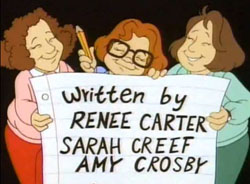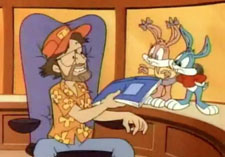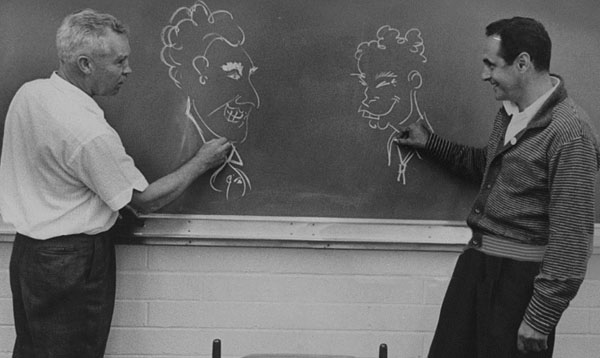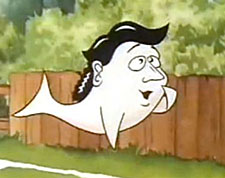 Anyone Can Write Cartoons. The New York Times on December 29,1990 pointed out that the newest writers for Tiny Toon Adventures were three eighth graders (Renee Carter, Amy Crosby and Sarah Creef) from Waynesboro, Virginia. The idea for a Tiny Toons’ story came to Carter one day at school and she began drawing the characters and laying out the story with help from Crosby and Creef.
Anyone Can Write Cartoons. The New York Times on December 29,1990 pointed out that the newest writers for Tiny Toon Adventures were three eighth graders (Renee Carter, Amy Crosby and Sarah Creef) from Waynesboro, Virginia. The idea for a Tiny Toons’ story came to Carter one day at school and she began drawing the characters and laying out the story with help from Crosby and Creef.
They produced a 200 page book and sent it to Warner Brothers where someone opened the package by mistake since the studio does not accept unsolicited material. It got passed along to higher ups and eventually to Steven Spielberg who liked it. Lawyers advised him against pursuing it since it would create a precedent and the studio would be swamped with scripts from school children.
 “But Steven wanted it and you don’t say ‘no’ to Steven Spielberg,” said Jean MacCurdy, vice president and general manager at the time of Warner Brothers Animation. They paid the kids a lump sum of $250 which they divided equally three ways and flew them and their parents out to Los Angeles for four days.
“But Steven wanted it and you don’t say ‘no’ to Steven Spielberg,” said Jean MacCurdy, vice president and general manager at the time of Warner Brothers Animation. They paid the kids a lump sum of $250 which they divided equally three ways and flew them and their parents out to Los Angeles for four days.
That story became “Buster and Babs Go Hawaiian”, the eighth episode of the second season (or episode 73). Basically, the characters have a nightmare of a vacation.
For the sharp-eyed animation fan, in the episode there is a brief glimpse of Jessica Rabbit’s legs, Roger Rabbit’s arm, Robin Williams and Dustin Hoffman as Peter Pan and Captain Hook (a reference to Spielberg’s film Hook) as well as Christopher Lloyd as Doc Brown, Andrew Lloyd Webber dressed up in a cat costume and George Lucas as Darth Vader. Spielberg provides the voice for his caricature. There are also caricatures of writers Nicholas Hollander, Paul Dini, and Sherri Stoner.
Hanna and Barbera. From the Asbury Park Press newspaper May 15, 1994 in a series of columns by Mark Voger:
Bill Hanna: “I think that – whether I should admit this or not – Joe and I even going back to Tom and Jerry have been very lucky at being able to do cartoons that have universal appeal. Tom and Jerry seemed to be well liked by adults as by children. The Flintstones, of course, was geared more to adults but I guess we were just lucky that the kids seemed to enjoy The Flintstones too. Maybe it was the gadgets but they seemed to enjoy it as much as the adults. So I honestly think we just kind of lucked out.”
Joe Barbera: “We were the first ones to turn to television. We had to. There was no other place for us to go. Television was brand new and we were turned down and rejected by everybody because they knew that making them was too expensive. Those cartoons we made for MGM cost anywhere from forty to sixty thousand dollars for five minutes. That’s what they were running. Finally, Screen Gems agreed to do a series of five minute shorts. I had worked up a storyboard and my daughter Jayne – she was about 12 –colored it at home. We went to Screen Gems and they kind of reluctantly decided to make a deal with us to produce five minute cartoons. And do you know what the budget we got for that was? $3,000. We went from $60,000 to $3,000.”

Bill Hanna: “In order to accomplish this, we had to change the way we made cartoons. In Tom and Jerry there was hardly any dialogue at all. It was all action. It required a great many drawings to make. When we made the cartoons for television, we used a lot more dialogue and not so many drawings are required for that.”
Joe Barbera: “We’d use every trick that we knew about. Taking drawings and moving them. Jiggling the screen. Zooming your camera in and out. Doing every trick you can to impart motion with the least amount of drawings. Now this is out of – either you call it Yankee ingenuity or desperation. But you have to remember that we had to do it. There was no market and there was no money. So we had to adapt. And what happened was, we rejuvenated the whole industry. No one was doing cartoons when we did that. It worked and it worked very, very well. The entire industry came back.”
Gary Krisel on Cartoon Violence. In Entertainment Weekly October 23, 1992, Gary Krisel, president of Disney’s television animation said, “There’s a difference between gratutious violence and the pure cartoon vernacular which so exceeds the level of reality. Efforts to police cartoon content could go too far. People who believe that TV is the equivalent of a textbook are being naïve. A program can’t do any good unless kids watch it. That’s not to say we’re not interested in education, but there is a place for entertainment.”
Billy the Fish. Billy the Fish was a long running comic strip in the British VIZ magazine about a half man/half fish goalkeeper named Billy Thompson who is pretty much a human head on a fish body that floats above the ground. The strip was meant to parody British football (soccer).
 Artist Chris Donald who drew the strip told the press in 1990, “We’ve been high profile for about five years now and ever since, people have been knocking on our door. A lot of thespians wanted to put VIZ on stage and a lot wanted to jump on the bandwagon in a ‘You’ve got something and we want it.”
Artist Chris Donald who drew the strip told the press in 1990, “We’ve been high profile for about five years now and ever since, people have been knocking on our door. A lot of thespians wanted to put VIZ on stage and a lot wanted to jump on the bandwagon in a ‘You’ve got something and we want it.”
Donald was a fan of Captain Pugwash (a series about a cowardly and pompous pirate) and felt that the style of animation would suit his character as well.
“Old-fashioned Walt Disney would be overdoing it. It’s a rubbish storyline and a hopeless idea so hopeless animation seems to suit it. There are a lot more potential pitfalls. Soundtrack is the difficult thing. We were fortunate that we got a low-budget soundtrack by Harry Enfiled. He recorded all the charater voices in a row and it was all done in about five takes.”
Donald was already so over committed that he did little more than write the scripts and approve the roughs for the cartoons. The animated movie ran on England’s Channel 4 in June 1990. It was re-aired in January 1991 as four separate episodes.


 Jim Korkis is an internationally respected animation historian who in recent years has devoted his attention to the many worlds of Disney. He was a columnist for a variety of animation magazines. With his former writing partner, John Cawley, he authored several animation related books including The Encyclopedia of Cartoon Superstars, How to Create Animation, Cartoon Confidential and Get Animated’s Animation Art Buyer’s Guide. He taught animation classes at the Disney Institute in Florida as well as instructing classes on acting and animation history for Disney Feature Animation: Florida.
Jim Korkis is an internationally respected animation historian who in recent years has devoted his attention to the many worlds of Disney. He was a columnist for a variety of animation magazines. With his former writing partner, John Cawley, he authored several animation related books including The Encyclopedia of Cartoon Superstars, How to Create Animation, Cartoon Confidential and Get Animated’s Animation Art Buyer’s Guide. He taught animation classes at the Disney Institute in Florida as well as instructing classes on acting and animation history for Disney Feature Animation: Florida.




















































Renee Carter is now an adult and has a blog about how she and her friends wrote that episode.
http://www.reneecarterhall.com/about.html
She is a fantasy writer today.
https://www.amazon.com/Five-Fortunes-Phil-Geusz/dp/1614501696/ref=sr_1_10?s=books&ie=UTF8&qid=1505460999&sr=1-10&keywords=renee+carter+hall
https://furplanet.com/shop/item.aspx?itemid=815
At least she never stopped pursuing her goal as a writer. I would think that is one positive aspect anyone could take to heart when it comes to being inspired by the things you love to become great at something.
The episode Buster and Babs Goes Hawaiian with the three tweenage girls from Virginia who wrote the episode inspired The Simpsons to do a spoof on that in the episode The Front where Bart and Lisa decided to write a episode of Itchy and Scratchy and sending the script to Itchy and Scratchy Studios, but only getting thier script rejected by I&S studio head Roger Meyers Jr. Undeterred Bart and Lisa decided to get their grandpa Abe as the writer and ghostwrite the future episodes of Itchy and Scratchy for him.
Regarding the Andrew Lloyd Webber cameo in Buster & Babs Go Hawaiian,I think they were spoofing the animated version of Cats that Spielberg planned to make back then. It was to have been done by his Amblinmation company but it never got off the ground.
That’s kind of interesting if that was in the planning.
Now I kinda wonder what the original 200-paged story that Renee, Sarah and Amy had in mind before the added embellishments were included in this episode. I suppose we’ll never know.
“But Steven wanted it and you don’t say ‘no’ to Steven Spielberg”
After Indiana Jones and the Kingdom of the Crystal Skull maybe someone should start.
Sometimes Hollywood’s funny that way.
Doug Walker (in character as The Nostalgia Critic) interviewed Renee Carter a year ago: https://www.youtube.com/watch?v=Hgc4jDp1Eg8
Also should note that while the three teens were credited for the episode, staff writer Nicholas Hollander filled out the script and was responsible for most of the first act before the “Hawaiian” plotline begins. Art Leonardi is the uncredited director of the episode- who, incidentally, is one of the few Golden Age animation staff members still with us.
Sad they wouldn’t give those guys credit here, but I guess they wanted to play up the mistique of this being a fan-submitted piece. I figured they’d have to add onto this with that first act or having the characters criticize the script itself with it’s plotholes and other oddities (like the lecture on q-tips). I figured the original story must’ve been one hell of a read to weave through when making this episode, but also glad they used TMS to animate it too.